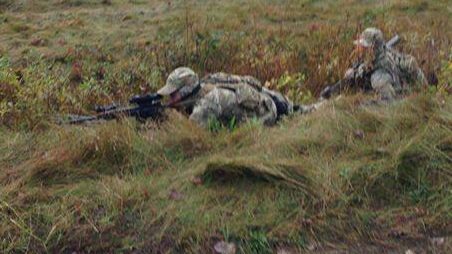Military’s counter-intelligence unit monitored Elsipogtog anti-fracking protests: documents
The Canadian military used its count-intelligence unit to monitor the aftermath of last October’s RCMP raid on a Mi’kmaq Warrior Society-led anti-fracking camp in New Brunswick in preparation for the eventuality the situation went “sideways,” according to internal document obtained by APTN National News.

(RCMP tactical officers scope the situation during Oct. 17, 2013, raid on Mi'kmaq Warrior anti-fracking camp. APTN/File)
The Canadian military used its counter-intelligence unit to monitor the aftermath of last October’s RCMP raid on a Mi’kmaq Warrior Society-led anti-fracking camp in New Brunswick in preparation for the eventuality the situation went “sideways,” according to an internal document obtained by APTN National News.
Senior officers with Joint Task Force Atlantic, which is headquartered in Halifax, were also trying to assess who was leading the protests locally and the reaction protests planned across the country following the Oct. 17, 2013 raid, according to the documents, including email, released under the Access to Information Act.
Camouflage and black-clad RCMP tactical officers wielding assault rifles dismantled a warrior-anchored camp blocking a compound in Rexton, NB, holding exploration vehicles used by a Houston-based energy firm to search for shale gas deposits near the Mi’kmaq community of Elsipogtog in New Brunswick.
The raid triggered daylong clashes between the Mi’kmaq, their Acadian and Anglophone supporters and the RCMP that led to 40 arrests and the torching of several RCMP vehicles. The RCMP said it seized hunting rifles, ammunition and crude explosive devices from the warriors that day.
The protests, driven by concerns the discovery of shale gas would lead to hydraulic fracturing and threaten the area’s water, continued into late November and saw tires burn twice on an area highway before the company, SWN Canada, finally ended their exploration work for the season.
According to the documents released to APTN National News and previous public comments by the RMCP and the military, no Canadian Forces personnel were involved in the raid. The military did provide the RMCP with space for a staging area at CFB Gagetown and the CF Moncton Detachment. The RCMP also requested the military provide its officers with field box lunches for between 60 to 100 personnel, according to a “Request for Canadian Forces Assistance” form submitted by the RCMP on Oct. 18.
While the Canadian military couldn’t engage directly with the protest without aid to the civil power request by the provincial government, the documents show individual officers were on alert even the Canadian Forces in the region did not shift posture.
“My (commanding officer) just wants to have me link with you in regards to the current events in Rexton,” wrote Capt. Grant McDonald, with the 2nd Battalion of the Royal Canadian regiment based in CFB Gagetown, in an Oct. 18 email to Capt. Don MacRea, with operation services of the 5th Canadian Division Support group also on the same base. “No panic here, we just want to have the right names and phone numbers if things go sideways.”
At headquarters in Ottawa, the military’s public affairs team was also put on alert.
“Team, please stay close to our Blackberries this weekend,” wrote Maj. Andre E. Salloum, in an Oct. 18 email to about 12 other people. “Just in case this situation escalates, we might have to man the office.”
Senior officers with joint Task Force Atlantic, headquartered in Halifax, were also trying to gather information on the ongoing local protest and the reaction-protests planned across the country.
Capt. Chris Hanley, with J3 Current Operations 2, sent an email on Oct. 18 to several individuals with a list of questions about the leaders of the protests and their level of coordination.
“What is the primary group (s) involved in the shale gas protests in NB? Is there any evidence that recent and planned protests are centrally directed or coordinated, or are the uncoordinated?” wrote Hanley. “Is there a direct there a direct threat to (Canadian Armed Forces) personnel/installations?”
APTN National News was not provided with the email containing the answer to those questions.
The Canadian Forces National Counter-Intelligence Unit, however, issued a report the same day from its Halifax detachment. The content of the released version of the report is heavily redacted. It does show that the unit was relying on three “tried and trusted” sources to gather intelligence on the situation.
The military was also receiving information from Government Operations Centre, which is the central nervous system for Ottawa’s response to incidents with potential national impacts. The federal government was preparing for nation-wide protests in response to the raid near Elsipogtog and distributed a map listing all the potential actions across the country.
The Government Operations Centre was also providing situational reports to the military which linked the events unfolding in New Brunswick to the Idle No More movement.
“While this incident was an environmental protest, it is linked to ongoing First Nation dissatisfaction with resource development and extraction in Canada as well as general dissatisfaction embodied in the Idle No More movement,” said the report.









